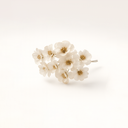How to Preserve Flowers? | Step 4 – Shaping Preserved Roses

How to Preserve Flowers? | Step 4 – Shaping
In the journey of how to preserve flowers, the shaping process marks a turning point where science meets artistry. After dehydration, glycerin infusion, and coloring, the preserved flowers are soft, pliable, and ready to take on their final form. This stage is entirely handcrafted — no machine can replace the precision and intuition of human touch.
What Does “Shaping” Mean in Preserved Flower Production?
At this stage, each bloom — especially preserved roses — undergoes careful, detailed adjustment. The artisan examines the petals one by one, reshaping their natural curve using fine tweezers, micro scissors, and shaping tools. The goal is not to make the flower perfect, but to restore the natural balance it once had as a fresh rose.
This step determines how the final preserved flower bouquet will look — its openness, petal layering, and symmetry. Every preserved flower at ZESO Blooms has gone through this delicate process, guided by human craftsmanship rather than automation.
Why Machines Can’t Replace Human Hands
Preserved flowers, unlike dried flowers or artificial ones, retain a soft, flexible texture. The slightest excess pressure can deform a petal, while inconsistent humidity can alter the structure. Machines lack the sensitivity to adapt to these natural variations.
Each preserved rose has its own unique shape, density, and petal tension. A skilled artisan uses intuition and years of experience to restore its lifelike bloom — something no algorithm or robotic arm can imitate. This is what gives forever roses their individuality and value.
The Human Craft Behind Every Forever Flower
It’s estimated that an experienced artisan can shape only about 100 to 120 preserved roses per day. Each piece requires a few minutes of inspection, adjustment, and finishing. During this process, imperfections are gently refined — petals are lifted, angles adjusted, and layers realigned to create balance and depth.
This meticulous attention to detail explains why preserved flowers and forever roses are more costly than fresh-cut blooms. Their value lies not only in longevity but also in the craftsmanship invested into every flower. When you buy a rose box or handmade bouquet from ZESO Blooms, you are not just purchasing a floral product — you are owning a piece of floral art.
Shaping Defines Value
Shaping is the final moment when the preserved flower’s story becomes tangible. It is where color, texture, and structure come together — held in place by human patience and artistry. No two flowers are ever identical, because each one reflects the artisan’s hand, touch, and aesthetic decision.
This is why forever flowers from ZESO Blooms stand apart: they embody the harmony of preservation science and human craftsmanship — a reminder that even in permanence, beauty is handmade.
ZESO Blooms – Create. Preserve. Inspire.



